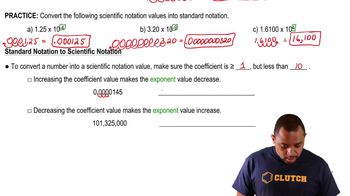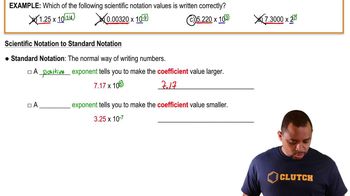Here are the essential concepts you must grasp in order to answer the question correctly.
Scientific Notation
Scientific notation is a way of expressing numbers that are too large or too small to be conveniently written in decimal form. It is represented as a product of a number (between 1 and 10) and a power of ten. For example, 3.221 × 10^-3 means 3.221 divided by 1000, which simplifies calculations and comparisons of very large or small values.
Recommended video:
Standard Notation to Scientific Notation
Standard Notation
Standard notation is the conventional way of writing numbers using digits without exponents. It represents the actual value of a number in a straightforward manner. Converting from scientific notation to standard notation involves calculating the power of ten and adjusting the decimal point accordingly, making the number easier to read and interpret.
Recommended video:
Scientific Notation to Standard Notation
Exponent Rules
Exponent rules are mathematical guidelines that dictate how to handle powers of ten during calculations. For instance, when multiplying or dividing numbers in scientific notation, you add or subtract the exponents, respectively. Understanding these rules is crucial for accurately converting between scientific and standard notation, especially when dealing with positive and negative exponents.
Recommended video:
 Verified step by step guidance
Verified step by step guidance


